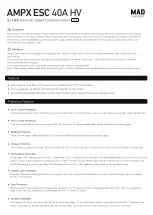
5
All paired receivers will play the same ringtone upon ringing.
Repeater mode is indicated upon sending signal to the next receiver by flashing of red LED.
You can pair an unlimited number of receivers into repeater mode.
Repeat the same procedure (activating pairing mode) for pairing each additional new receiver and the last
receiver in the line (switching the
button to position I).
All paired receivers are in parallel connection.
It is thus necessary that each paired receiver is powered throughout the entire course of its operation for the
repeater function to work properly.
Deactivating Repeater Mode
Switch the
button to position O on the chosen receiver.
The receiver will not forward signal to other paired receivers in the line upon ringing – the receivers after it
will not ring.
Installation of the Doorchime (Transmitter) Button
1. Begin by pairing the button with the chime.
2. Before installation, verify the reliable functioning of the set in the chosen spot.
3. Remove the rear cover with a screwdriver through a hole on the side of the button.
4. Use the double sided adhesive tape (included) or two screws to fix the rear portion of the cover to the wall.
Although the button is weather resistant, choose a location where it is protected, e.g. in a wall recess.
5. Re-assemble the button.
6. Press the button to ring the chime. Pressing is accompanied by LED illumination indicating the button has
sent a radio signal. The chime plays the selected melody.
Note: The doorchime button (transmitter) can be placed on wood or brick walls without issue.
However, never place the button directly onto metal objects or materials containing metal, such as plastic
window or door structures that have a metal frame. In such cases, the transmitter will not work properly.
Installing the Chime (Receiver)
1. The chime is designed for indoor use only and is powered by 3× 1.5 V AA batteries.
2. The transmission range (max. 120 m) is influenced by local conditions, such as the number of walls through
which the signal passes, metal door frames and other elements which affect the transmission of radio
signals (presence of other radio devices operating at a similar frequency, such as wireless thermometers,
gate controls etc.). The transmission range can decrease drastically due to these factors.
Troubleshooting
The chime is not ringing:
• The chime may be out of range.
−
Change the distance between the button and the chime; the range may be affected by local conditions.
• The chime battery may be flat.
−
Replace the battery. Make sure it has the correct polarity. Pair the button with the chime again.
• The chime is not powered.
−
The batteries in the chime may be flat.
−
Replace the batteries. Make sure it has the correct polarity. Pair the button with the chime again.
Содержание P5763
Страница 38: ...38 6 1 3 1 5 AA 2 120 1 5 1 2...
Страница 56: ...56 2 3 1 5V AA 60 3 60 4 1 3 1 5 V AA 8 60 60 1 2 3 60 B 4 1 2 B 3 4 100 75 50 25 0 25 50 75 100...
Страница 57: ...57 1 2 3 3 1 5 V AA 60 I O 1 2 3...
Страница 58: ...58 4 5 6 1 3 1 5 V AA 2 120 m 1 5 V 1 2V...
Страница 59: ...59 EMOS spol s r o P5763 2014 53 http www emos eu download...






































